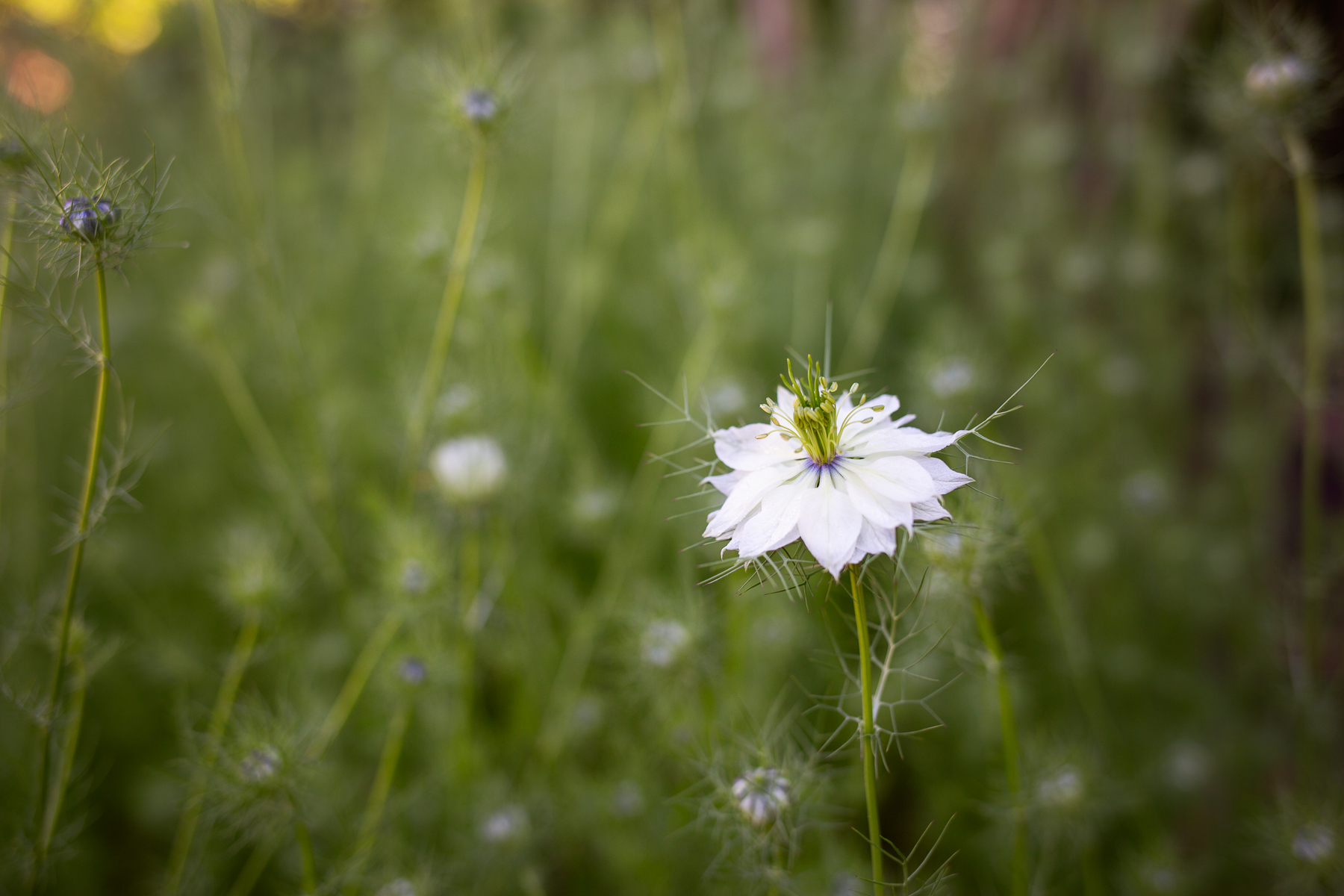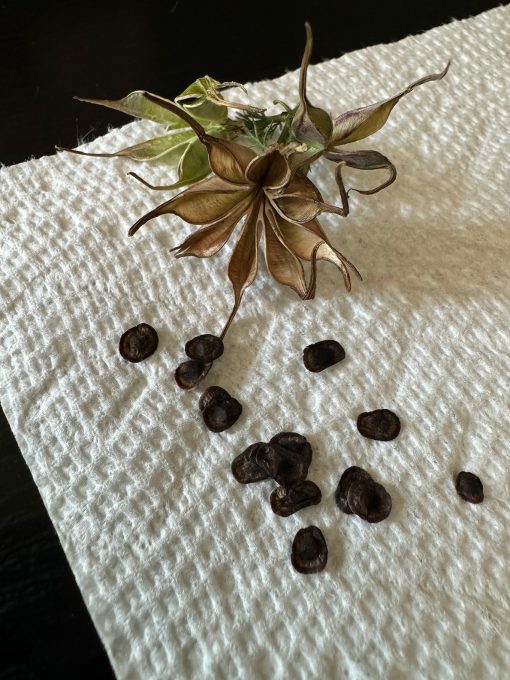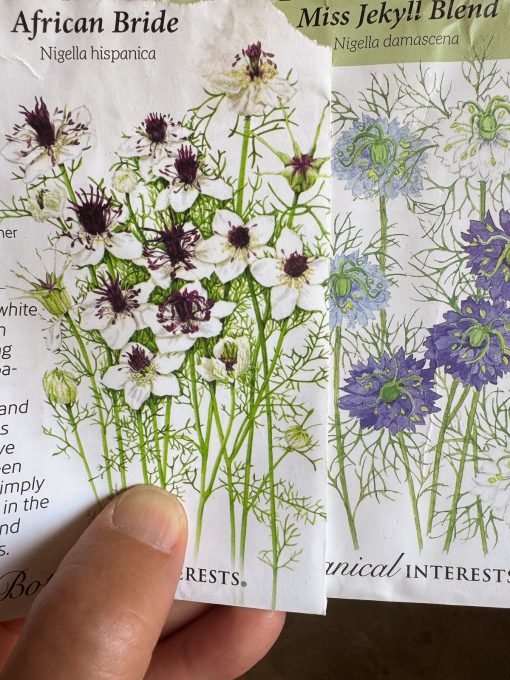Love-in-a-Mist Flowers
An Anthophile’s Delight
First published in the September 2024 edition of Grapevine, the newsletter for Yamhill County Master Gardeners.
A sign you might be an anthophile is an unrelenting gravitational pull to flowers. You go where they grow. To a pub decorated with begonias in London. To a cottage garden in Georgia overflowing with love-in-a-mist. To a roadside ditch in Sherwood dotted with sweet peas.
Blossom intricacies and the myriad of hues fill anthophiles with wonder and delight. Each flower encountered is a fascinating new character with a yet undiscovered story.
Flowers demand curiosity. Even astonishment. And the anthophile’s calling is to tell about it.
“But one of the things that I learned is that (…) noticing what delights me, and then naming it, recognizing it, and then sharing it, is a kind of profound way of connecting,” said Ross Gay, author of The Book of Delights. “(…) Maybe it’s a beckoning, even. It’s definitely a reaching and it’s a way of probably being like, do you love this too? We might love this thing together.”
As a self-declared anthophile I must share the story of love-in-a-mist. The wispy fronded flower, Nigella damascena, has many melodious – and hyphenated – names. Devil-in-a-bush, Jack-in-the-green, and lady-in-the-bower. Less imaginative names include Damascus black cumin and fennel flower.
Love-in-a-mist was a common cottage garden flower in Europe by the sixteenth century. Seeds made their way to the colonies by the eighteenth century. Henry Middleton of South Carolina is on record with his seed order in 1800.
I am woefully behind. I only met the flower’s acquaintance in the spring of 2024 on the grounds of Georgia’s Barrington Hall (built 1842).
The self-guided, cottage garden path tour began with no surprises. Peonies and columbines. But as I turned a corner, a dense thicket of fennel-like foliage caught my eye. Then the stars emerged. Like the night sky, first one star appears, then hundreds more.
After taking many, many photos, it was obvious I could not leave without this flower. I explained my “need” to press and preserve a few to the head gardener. He smiled and said, “just be discreet.” The two blossoms pressed with perfect results. I began dreaming of a space for a crop of my own. When I received a copy of Floret Farm’s Cut Flower Garden, I knew I needed to get planting. Author Erin Benzakein singles out the flower as “one of the hardiest early bloomers around.”
Benzakein advises harvesting flowers fully open, but before petals separate from the center. They last for a good week in a vase.
Nosegays of old-fashioned flowers like Nigella damascena often delivered a message. In the language of flowers, love-in-the-mist means perplexity. It can also mean the sender is open to love or, the more direct, “kiss me.”
Love-in-a-mist cultivars often have extra rows of sepals (double flowers). They come in a wide range of colors from white to blue to pink. Because of the flower’s long taproot, Nigella does not transplant well. Seeds are sown directly in the fall or early spring as soon as ground can be worked. Repeated sowing every 3-4 weeks works until mid-summer. The plants are rarely affected by serious pests or diseases. They enjoy full sun and appreciate well-drained soil.
Ignoring the “do not transplant” advice, I purchased one gangly Nigella orientalis ‘Transformer’ in May. The only one I had the luck to find. Yellow is a variety left off most lists when talking about Nigella, but the buttery color is lovely. The plant is alive with seed heads forming. A hopeful investment in next spring.
Nigella’s intriguing puffed, papery seed pods are almost as coveted as the flowers. My planned area keeps gets larger by the day. I need space for flowers, dried pods for fall arrangements, and pods for scattering next year’s crop.
And, evidently I also “need” seeds to go in my spice jar.
Nigella damascena is closely related to Nigella sativa. The latter is beloved in India, Iran, and the Middle East for its culinary and medicinal purposes. The sativa seeds are used like sesame and poppy seeds. Sometimes they are briefly fried or toasted and added to pickles, chutneys, and sauces. They are believed to remedy digestive, respiratory, rheumatic, and skin problems. The culinary gems are easy to order in bulk online.
Thomas Jefferson planted Nigella sativa in an oval flower bed at Monticello in 1810. At Mount Vernon you will find Nigella damascena in the upper garden. Nigella refers to the black color of the seeds. Those that are damascena “from Damascus” reportedly smell like strawberries and taste more of nutmeg than onion.
The popularity of Nigella damascena in the cottage gardens is credited to Gertrude Jekyll (1843-1932). Gertrude was a beloved British horticulturist, garden designer, craftswoman, photographer, writer and artist. She was noted for her painterly approach to garden design.
Gertrude valued the vivid blue flower of love-in-a-mist. A Nigella damascena variety was named after her early in her career. It’s unclear if she was involved in the breeding process or was simply an admirer.
I was able to purchase a packet of ‘Miss Jekyll’ seeds along with a packet of Nigella hispanica, the Spanish fennel flower. The seedlings are healthy but are yet to bloom. Fingers crossed. More seeds will be scattered by hand regardless.
One last fun fact in the story of love-in-a-mist. Gertrude Jekyll’s younger brother Walter was friends with the author Robert Louis Stevenson. The writer borrowed the Jekyll family name for his most notorious creation, the main character of The Strange Case of Dr. Jekyll and Mr. Hyde.
May I propose one more hyphenated name for love-in-a-mist? “Bride-of-Frankenstein” has a lovely ring to it.






So informative. What a gorgeous flower!!